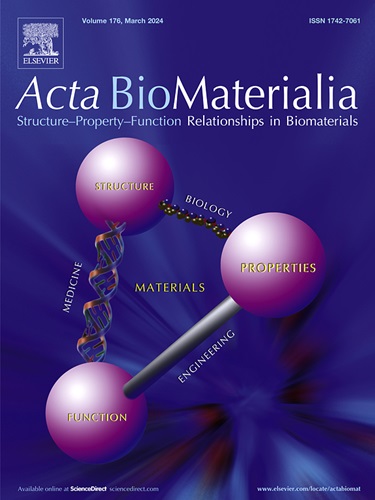用于抗肿瘤治疗的铜基生物材料:最新进展与展望》。
IF 9.4
1区 医学
Q1 ENGINEERING, BIOMEDICAL
引用次数: 0
摘要
铜是一种重要的微量元素,与生物系统中的许多代谢途径密不可分。近年来,铜基生物材料因其优越的生物相容性和多方面的功能而备受关注,尤其是在治疗肉瘤和癌症等恶性肿瘤方面。一方面,这些铜基材料可作为一系列治疗药物(包括化疗药物、小分子抑制剂和抗体)的高效载体,在特定修饰和刺激下实现精确输送和控制释放。另一方面,它们可以通过铁跃迁、杯跃迁、细胞凋亡和热跃迁等机制诱导细胞死亡,或通过其出色的特性抑制癌细胞的增殖和侵袭。此外,先进的设计方法使这些材料能够支持肿瘤成像和免疫激活。尽管取得了这些进展,但它们的全部功能仍有待全面阐明。本综述概述了铜基生物材料的抗肿瘤功能、内在机制和设计策略,以及它们的优势和局限性。目的是为新型多功能生物材料的设计、研究和开发提供见解,最终目标是加速铜基纳米材料在癌症治疗中的临床应用。意义说明:这项研究探索了铜基生物材料在癌症治疗中的突破性潜力,它独特地将生物相容性与靶向药物递送和通过特定细胞死亡途径抑制癌细胞等多种治疗机制结合在一起。通过增强肿瘤成像和免疫激活,铜基纳米材料为癌症治疗开辟了新途径。本综述对这些多功能生物材料进行了研究,强调了它们的优势和目前的局限性,同时探讨了现有研究的不足之处。研究结果旨在加快这些材料在肿瘤学领域的临床应用,为设计下一代铜基疗法提供有价值的见解。因此,这项工作与专注于癌症创新治疗的研究人员和从业人员密切相关。本文章由计算机程序翻译,如有差异,请以英文原文为准。

Copper-Based biomaterials for anti-tumor therapy: Recent advances and perspectives
Copper, an essential trace element, is integral to numerous metabolic pathways across biological systems. In recent years, copper-based biomaterials have garnered significant interest due to their superior biocompatibility and multifaceted functionalities, particularly in the treatment of malignancies such as sarcomas and cancers. On the one hand, these copper-based materials serve as efficient carriers for a range of therapeutic agents, including chemotherapeutic drugs, small molecule inhibitors, and antibodies, allowing them for precise delivery and controlled release triggered by specific modifications and stimuli. On the other hand, they can induce cell death through mechanisms such as ferroptosis, cuproptosis, apoptosis, and pyroptosis, or inhibit the proliferation and invasion of cancer cells via their outstanding properties. Furthermore, advanced design approaches enable these materials to support tumor imaging and immune activation. Despite this progress, the full scope of their functional capabilities remains to be fully elucidated. This review provides an overview of the anti-tumor functions, underlying mechanisms, and design strategies of copper-based biomaterials, along with their advantages and limitations. The aim is to provide insights into the design, study, and development of novel multifunctional biomaterials, with the ultimate goal of accelerating the clinical application of copper-based nanomaterials in cancer therapy.
Statement of significance
This study explores the groundbreaking potential of copper-based biomaterials in cancer therapy, uniquely combining biocompatibility with diverse therapeutic mechanisms such as targeted drug delivery and inhibition of cancer cells through specific cell death pathways. By enhancing tumor imaging and immune activation, copper-based nanomaterials have opened new avenues for cancer treatment. This review examines these multifunctional biomaterials, highlighting their advantages and current limitations while addressing gaps in existing research. The findings aim to accelerate clinical applications of these materials in the field of oncology, providing valuable insights for the design of next-generation copper-based therapies. Therefore, this work is highly relevant to researchers and practitioners focused on innovative cancer treatments.
求助全文
通过发布文献求助,成功后即可免费获取论文全文。
去求助
来源期刊

Acta Biomaterialia
工程技术-材料科学:生物材料
CiteScore
16.80
自引率
3.10%
发文量
776
审稿时长
30 days
期刊介绍:
Acta Biomaterialia is a monthly peer-reviewed scientific journal published by Elsevier. The journal was established in January 2005. The editor-in-chief is W.R. Wagner (University of Pittsburgh). The journal covers research in biomaterials science, including the interrelationship of biomaterial structure and function from macroscale to nanoscale. Topical coverage includes biomedical and biocompatible materials.
 求助内容:
求助内容: 应助结果提醒方式:
应助结果提醒方式:


